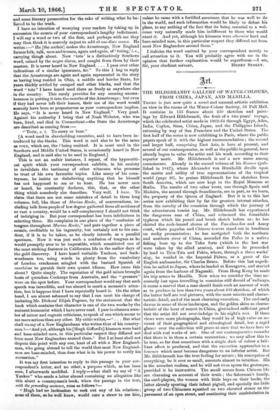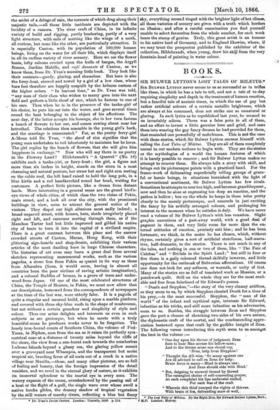Alt
THE HILDEBRANDT GALLERY OF WATER-COLOURS, FROM CHINA, JAPAN, AND MANILLA.
THERE is just now quite a novel and unusual artistic exhibition on view in the rooms of the Water-Colour Society, 53 Pall Mall. It contains in 133 frames about 250 sketches and paint- ings by Edward Hildebrandt, the fruit of a two years' voyage, which the celebrated artist made in 1862-64 through Egypt, Aden, India, Ceylon, Siam, China, Japan, and the Philippine Islands, returning by way of San Francisco and the United States. The first half of the series is now exhibiting in Paris, where the public papers speak of it with the highest recommendation ; the second and larger half, comprising East Asia, is here at present, and several of our contemporaries, as well as the public in general, have already begun to value the artist and his work according to their superior merit. Mr. Hildebrandt is not a new name among connoisseurs. Already in the second volume of his Kosnws (pub- lished in 1847), where Alexander von Humboldt dwells upon the merits and utility of true representations of the tropical world (page 86), he praises Hildebrandt for his sketches from South America, which are now kept in the Royal Museum at Berlin. The results of two other tours, one through Spain and Madeira, the second through Scandinavia, are in part, as we learn, the property of the Queen of England. But it is to this last series now exhibiting that by far the greatest interest attaches, from the novelty of the countries through which the journey of the adventurous tourist lay. Mr. Hildebrandt has experienced the dangerous seas of China, and witnessed the formidable typhoon which his pencil and brush sketch before us ; he has skirted the rock-bound shOres of the Foo-choo-foo and Amoy coast, where pagodas and Chinese towers stand out in loneliness on rocky promontories; he has navigated both the northern and southern river of China, ascended the Peiho in a native fishing boat up to the Taku forts (which in the last war were taken by the allied armies), and thence he proceeded by land to Tien-Tsin and Pekin, where, through a three weeks' stay, he resided in the Imperial Palace, as a guest of the English ambassador, Sir Charles Bruce. Before this last expedi- tion he sailed to Japan, where he landed at Kanagawa, and started again from the harbour of Nagasaki. From Hong Kong he made his trip across to Manilla. Now when we consider the time ne- cessarily lost upon travelling in countries still devoid orrailways, it seems a marvel that a man should finish such an amount of work as to produce in less than two years about 400 sketches, of which the better half are real pictures, with the most minute and charac- teristic detail, and of the most charming execution. The cool early dawns in some of these landscapes, and the golden skies so charac- teristic of the hour of sunset in China, give indeed sufficient proof that the artist did not over-indulge in his night's rest. If these views were mere photographs, they would be of high value on ac- count of their geographical and ethnological detail, but a rapid glance over the collection will prove at once that we have here to deal with real works of art. One of our contemporaries remarks that there is in them a certain mannerism ; we may allow this to be true, so far that sometimes with a single dash of colour a bril- liant effect is produced, and that the execution approaches to a bravura which must become dangerous to an inferior artist. But Mr. Hildebrandt has the true feeling for nature ; his conception of everything, be it ever so small, amounts almost to intuition. His is the soundest realism, and he will not even spurn the grotesque, provided it be instructive. The small scenes from Chinese life are charming on account of their truth ; the fisherman's family, the card-players, the women with little boys on their backs, the latter already sporting their infant pigtail, and specially the little group of two Chinamen squatted on two elevated stones on the pavement of an open street, and continuing their confabulation in the midst of a deluge of rain, the torrents of which drag along their majestic tails,—all these little incidents are depicted with the lucidity of a camera. The river craft of China, in its infinite variety of build and rigging, partly lumbering, partly of a very light structure, with sails of matting like the wings of a moth, all curious, but none like the other, are particularly attractive. It is especially Canton, with its population of 360,000 human beings, living on the water for all their life, which displays itself in all its endless variety of river scenery. Here we see the flower boats, lofty saloons erected upon the hulls of barges, the Argyll Rooms, Jardins Mabille, and café dansanta of Canton, as we know them, from Dr. Yvan's amusing little book. They look like their contents—gaudy, glaring, and shameless. But here is also the ferry-boat, steered and rowed by a girl of a low class, whose bare feet therefore are happily unspoilt by the hideous custom of the higher orders. " In harvest time," so Dr. Yvan was told, " any man of their class who wishes to marry goes into the next field and gathers a-little sheaf of rice, which he fastens to one of his oars. Then when he is in the presence of the tanka-girl of his choice, he puts his oar into the water, and goes several times round the boat belonging to the object of his affections. The next day, if the latter accepts his homage, she in her turn fastens a bunch of flowers to her oar, and comes rowing about near her betrothed. The relations then assemble in the young girl's bark, and the marriage is consecrated." For, as the pretty ferry-girl A-Moun told Dr. Yvan, " the sheaf of rice signifies that the young man undertakes to toil laboriously to maintain her he loves. The girl replies by the bunch of flowers, that she will give him happiness in exchange." Now who will say there is no poetry in the Flowery Land? Ilildebrandt's "A Quarrel" (No. 18) exhibits such a tanka-yiri, or ferry-boat ; the girl, a figure not more than six inches in height, stands on the stern in a most charming and natural posture, her straw hat and right arm resting on the cabin roof, the left hand raised to hold the long pole, in a blue kirtle and a red handkerchief round her head, waiting for customers. A perfect little picture, like a dream from distant lands. More interesting in a general sense are the grand bird's- eye views of whole cities, of which class the two vistas of Pekin, main street, and a look all over the city, with the prominent buildings in view, seem to attract the general notice of the visitors. They dispel our high allusions most sadly indeed ; a broad unpaved street, with houses, huts, sheds irregularly placed right and left, and caravans moving through them, as if the Manchoo Tartar had but little improved and gilded his native city of tents to turn it into the capital of a civilized empire. There is a great contrast between this place and the narrow crowded streets of Canton, Macao, Hong Kong, with their glittering sign-boards and shop-fronts, exhibiting their various articles of the most dazzling hues in large Chinese characters. The historian of art even may learn a great deal from several sketches representing monumental works, such as the various pagodas, a stone lion from Pekin as quaint in its way as those from Alhambra (lions, it would seem, having in almost all countries been the poor victims of raving artistic imagination), and a colossal Buddha of bronze, in a grove of trees and under- wood from Japan. Of one of the most celebrated structures of China, the Temple of Heaven, in Pekin, we must now allow that our descriptions, borrowed from the correspondents of newspapers at the time of the last war, were utterly false. It is a pagoda of quite a singular and unusual build, rising upon a marble platform and covered with three sky-blue roofs in the shape of mushrooms, but not without a certain grandeur and simplicity of style and colour. Thus our artist delights and interests us even in such subjects as are grotesque, but when he meets with a truly beautiful scene he produces works never to be forgotten. The lonely iron-bound coasts of Southern China, the volcano of Fusi- Yama, in Niphon, seen from the sea as it raises its perfectly sym- metrical cone at a distance of twenty miles beyond the cliffs of the shore, the view from a sun-burnt rock towards the numberleSs Ladrone Islands beyond a glassy sea, the glaring yellow sunset over a graveyard near Whampoa, and the transparent but moist tropical air, breeding fever of all sorts out of a creek in a native village near Manilla,—these, and many other pictures, are so full of feeling and beauty, that the foreign impression of the detail vanishes, and we revel in the eternal glory of nature, as it exhibits its immortal splendour to the mortal eye in every zone. The watery expanse of the ocean, overshadowed by the passing sail of a boat or the flight of a gull, the single wave over whose swell a native lorcha glides, the dreamy shadow of tropical vegetation by the still waters of marshy rivers, reflecting a blue but fleecy • Dr. Yvalie Inside Canton. London: Vizandly, 1858. p.158.
sky, everything around tinged with the brighter light of hot climes, all these varieties of scenery are given with a truth which borders on illusion ; and after a careful examination you find yourself unable to select favourites from the whole number, for each work bears the stamp of genius. Truly, this great artist is an honour to his native land of Germany, and to England likewise, where, if we may trust the prospectus published by the exhibitor of the collection, Hildebrandt, when young, drew his skill from the very fountain-head of painting in water colour.































 Previous page
Previous page